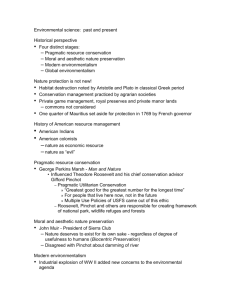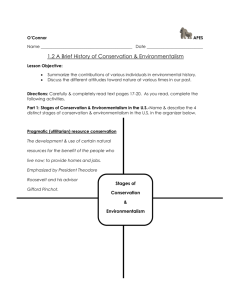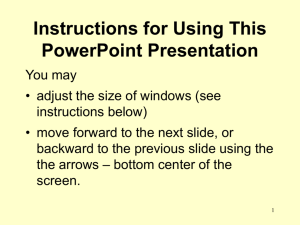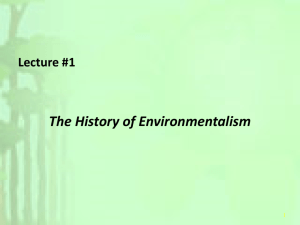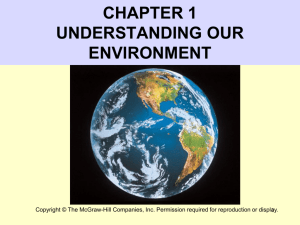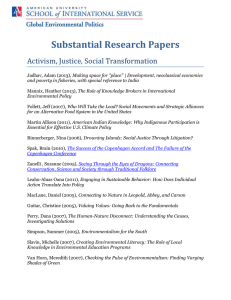Understanding Our Environment Chapter 1 Summary Outline: 1.
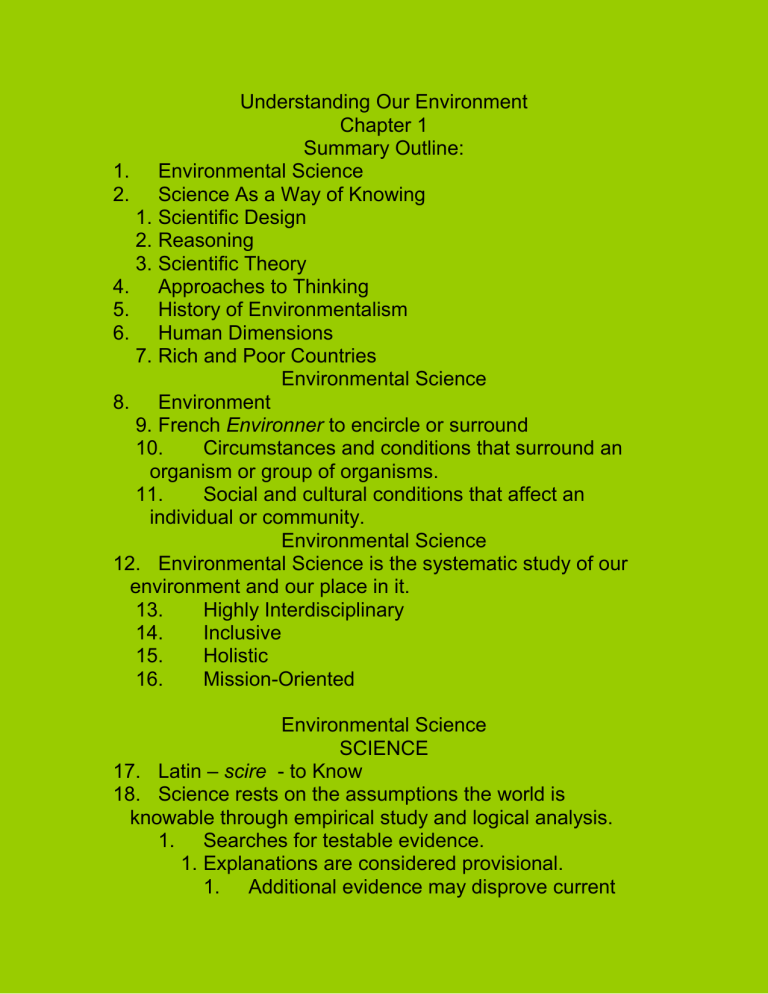
Understanding Our Environment
Chapter 1
Summary Outline:
1. Environmental Science
2. Science As a Way of Knowing
1. Scientific Design
2. Reasoning
3. Scientific Theory
4. Approaches to Thinking
5. History of Environmentalism
6. Human Dimensions
7. Rich and Poor Countries
Environmental Science
8. Environment
9. French Environner to encircle or surround
10. Circumstances and conditions that surround an organism or group of organisms.
11. Social and cultural conditions that affect an individual or community.
Environmental Science
12. Environmental Science is the systematic study of our environment and our place in it.
13. Highly Interdisciplinary
14. Inclusive
15. Holistic
16. Mission-Oriented
Environmental Science
SCIENCE
17. Latin – scire - to Know
18. Science rests on the assumptions the world is knowable through empirical study and logical analysis.
1. Searches for testable evidence.
1. Explanations are considered provisional.
1. Additional evidence may disprove current
theories.
Table 1.1
Science As a Way of Knowing
2. Scientists collaborate
3. Many people often work on different aspects of a problem.
4. Creativity, insight, aesthetics and even luck play roles in scientific research.
Scientific Design
5. Reproducibility
6. Experiments must be designed and recorded so they can be reproduced exactly by other researchers.
7. Controlled Studies
8. Comparisons are made between experimental and control populations.
9. Every variable except the one being studied is held constant.
Scientific Design
10. Blind Experiment
11. Conducted so investigators do not know which is the control and which is the experimental group, until after data have been gathered and analyzed.
12. Double-Blind
13. Neither the subject nor the investigators know which participants are receiving an experimental treatment.
Reasoning
1. Deductive
1. Reasoned conclusion
2. Starting with a general principle and deriving a testable predication about a specific case.
1. Premise: All dogs have four legs.
2. Premise: Rover is a dog,
3. Conclusion: Rover has four legs.
Reasoning
4. Inductive
1. Specific examples are examined to locate patterns and derive general explanations from collected observations.
2. Reasoning from particular instances to a general conclusion
3. if all the people you've ever met from a particular town have been very strange, you might then say
"all the residents of this town are strange"
Hypotheses and Theories
4. Hypothesis
5. Conditional explanation that can be tested by further observation or experiment.
6. Logically, an hypothesis is based on inductive reasoning, can be shown to be wrong, but can almost never be shown to be unquestionably true.
7. Evidence is always provisional.
8. Scientific Theory
Scientific Method
Modeling and Natural Experiments
9. In some areas, historic evidence can be examined for support or contradiction of an idea.
10. Another method of investigation is using a model simulating the phenomenon under study.
11. Models re presents researchers’ assumptions about how a system works.
12. Can produce contradictory results.
Statistics and Probability
13. Probability
14. An attempt to measure and predict the likelihood of an event.
15. Sample Size
16. A critical experimental variable is the number of observations necessary in order to have a reliable representation of a population.
Paradigms and Scientific Consensus
17. Paradigms
18. Overarching model of the world that guides our interpretations of events.
19. Tend to guide the types of questions asked by
investigators.
20. Paradigm shifts occur when a majority of scientists agree the older general explanations no longer fit the observations.
Approaches to Knowledge and Thinking
21. Analytical Thinking
22. How can I break this problem into parts ?
23. Creative Thinking
24. How can I approach this differently ?
25. Logical Thinking
26. How can deductive reasoning help ?
27. Critical Thinking
28. What am I trying to do ?
29. Reflective Thinking
30. What does it all mean ?
Steps in Critical Thinking
31. Identify and evaluate premises and conclusions in an argument.
32. Acknowledge and clarify uncertainties, vagueness, equivocation, and contradictions.
33. Distinguish between facts and values.
34. Recognize and assess assumptions.
35. Distinguish source reliability or unreliability.
36. Recognize and understand conceptual frameworks.
History of Conservation and Environmentalism
37. Four Distinct Stages:
38. Pragmatic Resource Conservation
39. Moral and Aesthetic Nature Preservation
40. Modern Environmentalism
41. Global Environmental Citizenship
Pragmatic Resource Conservation
42. President Theodore Roosevelt and his chief conservation advisor, Gifford Pinchot, believed in utilitarian conservation.
43. Forests should be saved so they can be used to
provide homes and jobs.
44.
Should be used for “the greatest good for the greatest number, for the longest time.”
Moral and Aesthetic Nature Preservation
45. John Muir, first president of the Sierra Club, opposed
Pinchot’s utilitarian policies.
46. Biocentric Preservation
47. Emphasizes the fundamental right of all organisms to pursue their own interests.
Modern Environmentalism
48. Rachel Carson, Silent Spring .
49. Awakened the public to threats of pollution and toxic chemicals to humans as well as other species.
50. Modern environmentalism extends concerns to include both natural resources and environmental pollution.
Global Concerns
51. Increased travel and communication enables people to know about daily events in places unknown in previous generations.
52. Common environment shared on a global scale.
53. Global Environmentalism
CURRENT ENVIRONMENTAL CONDITIONS
54. Causes of Environmental Degradation
55. More than 6 billion people now occupy the earth, and we add about 85 million more each year.
56. Most growth will be in poorer countries where present populations already strain resources and services.
Human Dimensions of Environmental Science
57. A small fraction of the worl d’s population live in increasing luxury, while a more than 1.3 billion people live in acute poverty.
58. Seventy percent are women and children.
59. Often meet short-term survival needs at the cost of
long-term sustainability.
60. Cycle of poverty, illness and limited opportunities become cyclic.
Fig. 1.15
Rich and Poor Countries
61. About 20% of the worlds population lives in the twenty richest countries.
62. Average per capita income above $25,000.
63. Other 80% live in middle or low-income countries.
64. Ten poorest countries each have average per capita income of less than $200.00.
65. Richest 200 people in the world have have a combined wealth of $1 trillion.
66. More than total owned by poorest half of the world population (3 billion).
Table 1.4
Sustainability
67. Sustainable Development
68. “Meeting the needs of the present without compromising the ability of future generations to meet their own needs.”
Indigenous Peoples
69. Indigenous peoples are generally among the least powerful, most neglected groups.
70. In many countries, traditional caste systems, discriminatory laws, economics, or prejudices repress indigenous peoples.
71. In many places, indigenous people in traditional homelands guard undisturbed habitats and rare species.
72. Recognizing native land rights may safeguard ecological processes.
Summary:
73. Environmental Science
74. Science As a Way of Knowing
75. Scientific Design
76. Reasoning
77. Scientific Theory
78. Approaches to Thinking
79. History of Environmentalism
80. Human Dimensions
81. Rich and Poor Countries
RETURN to Lecture notes page
